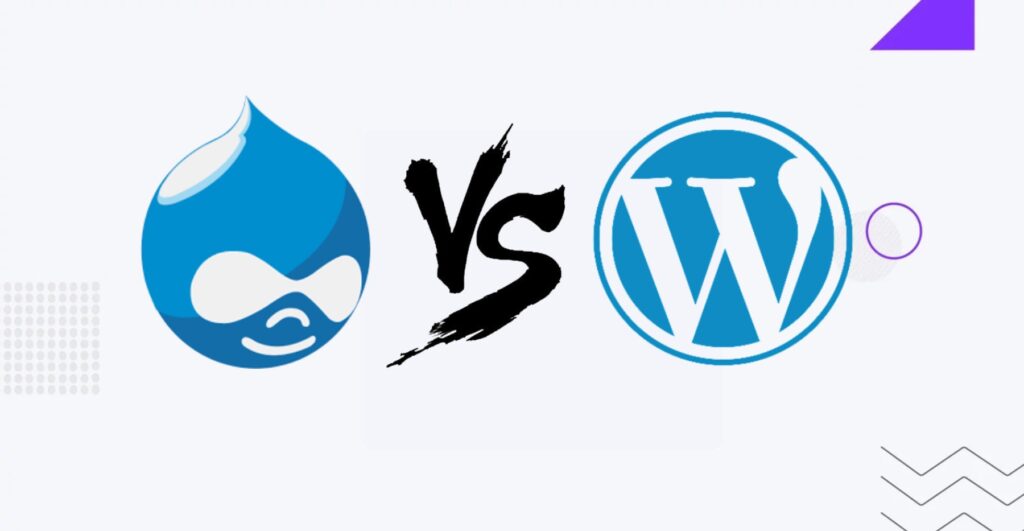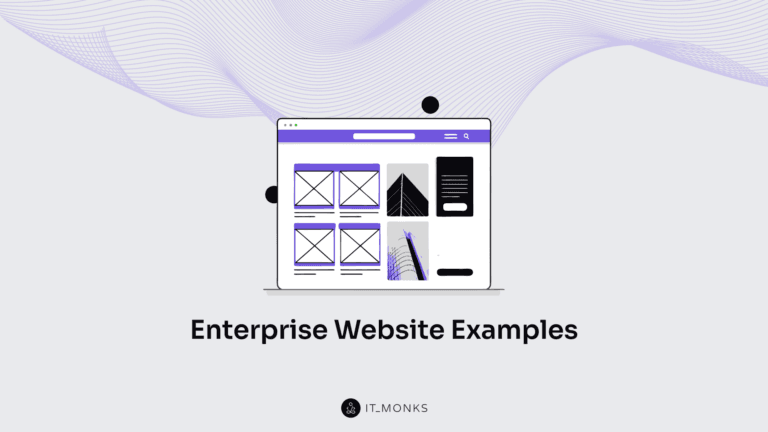Drupal vs WordPress for Ecommerce Detailed Comparison
Table of Contents
Table of Contents

There are many content management systems available. However, not all of them let you create a fully functional ecommerce website. That’s when WordPress and Drupal come up as two unbeatable leaders in the industry. When launching your online store or enhancing your current site with ecommerce functionality, which of these two options works best Drupal vs WordPress for ecommerce?
Initially released as a blogging CMS, WordPress has evolved into a robust platform for building conversion-oriented ecommerce websites. Drupal, being less user-friendly and simple than WordPress, is no less extendable and features many ecommerce modules vital for launching a competitive online store. Both CMSs have their pros and cons and peculiarities that other platforms lack. So, which one works best for you? Let’s find it out in our Drupal vs WordPress for ecommerce comparison.
Platforms Overview
Drupal, established in 2001 by Dries Buytaert, is a stalwart in content management systems. With its foundation in PHP and robust community backing, Drupal has solidified its reputation for flexibility, scalability, and top-tier security. Over the years, it has transformed into a powerhouse platform capable of supporting intricate websites, including ecommerce ventures.
On the other hand, WordPress, born in 2003 through the efforts of Matt Mullenweg and Mike Little, has surged to the forefront of CMS popularity. Initially conceived as a blogging tool, WordPress has evolved into a versatile solution, empowering users of all skill levels with its user-friendly interface and an extensive library of plugins. Notably, when comparing Drupal vs. WordPress for ecommerce, the latter’s e-commerce capabilities, epitomized by plugins like WooCommerce, have propelled WordPress to power many of the internet’s websites.
WordPress
WordPress has grown into the most popular CMS globally, powering over one-third of all websites on the Internet. Initially a blogging platform, WordPress has expanded its capabilities to cater to various website needs, including ecommerce.
Key Features:
- WordPress is known for its intuitive interface, making it accessible to all skill levels.
- With thousands of plugins available, including popular ecommerce solutions like WooCommerce, WordPress offers extensive functionality.
- WordPress boasts a massive community of users and developers, providing abundant resources and support.
Need to build a WP store?
Drupal
Drupal is an open-source CMS written in PHP. It boasts a strong community and is renowned for its flexibility and scalability. Over the years, Drupal has evolved into a powerful platform suitable for building complex websites, including ecommerce stores.
Key Features:
- Drupal offers extensive customization options, allowing developers to create highly tailored ecommerce solutions.
- It can handle large amounts of content and traffic, making it suitable for growing businesses.
- Drupal prioritizes security with regular updates and a dedicated security team.
Ecommerce Capabilities

When deciding whether WordPress or Drupal better suits your ecommerce needs, you need to understand both platforms’ ecommerce capabilities. Below, we highlight Drupal vs WordPress for ecommerce specifications, scalability, and performance peculiarities.
Drupal for Ecommerce
Ecommerce Drupal capabilities are primarily augmented through modules like Drupal Commerce and Ubercart. These modules provide product management, shopping cart functionality, and order processing features.
Modules and Plugins Available for Ecommerce:
- Drupal Commerce: A powerful ecommerce framework for Drupal, offering extensive customization options and integrations.
- Ubercart: A simpler solution for smaller ecommerce websites, providing essential features out of the box.
Flexibility and Customization Options:
- Drupal offers unparalleled flexibility, allowing developers to tailor every aspect of the ecommerce experience to their specific requirements.
- Customization options range from design and layout to functionality and workflow, catering to businesses of all sizes and industries.
Scalability and Performance:
- Drupal’s architecture enables scalability, making it suitable for large ecommerce operations with high traffic volumes.
- Performance optimization may require more technical expertise than other platforms but can result in highly optimized ecommerce websites.
WordPress for Ecommerce
WordPress’s ecommerce capabilities are primarily facilitated through plugins, with WooCommerce being the most popular and widely used WordPress ecommerce plugin. WooCommerce transforms a WordPress website into a fully functional ecommerce store with product management, payment processing, and order fulfillment features.
Popular Ecommerce Plugins (e.g., WooCommerce):
- WooCommerce: Powering millions of ecommerce websites worldwide, WooCommerce is an ecommerce WordPress plugin that offers a user-friendly interface and extensive customization options.
- Easy Digital Downloads (EDD): Ideal for selling digital products, EDD provides a streamlined ecommerce solution tailored to digital content creators.
Ease of Use and Setup:
- WordPress’s intuitive interface makes it easy for users to set up and manage their ecommerce store without extensive technical knowledge.
- Plugins like WooCommerce streamline the setup process, guiding users through configuring products, payment gateways, and shipping options.
Scalability and Performance:
- While WordPress can handle small to medium-sized ecommerce websites effectively, scalability may become an issue for larger operations with high traffic volumes.
- Performance optimization techniques, such as caching and content delivery networks, are essential for maintaining optimal performance as traffic grows.
Customization and Flexibility

WordPress and Drupal offer robust customization and design flexibility, but they cater to different audiences. WordPress is ideal for users seeking an easy-to-use platform with many themes and plugins. At the same time, Drupal is suited for developers needing a highly customizable and flexible system for complex projects.
Let’s take a closer look at how each platform handles customization, including Drupal vs WordPress for ecommerce themes and design flexibility.
WordPress
WordPress offers extensive customization options through its themes and plugins. There are plenty of WordPress free and premium theme solutions that can be easily installed and customized without any coding knowledge. Users can tweak website appearances in real time using the built-in customizer, adjusting colors, fonts, layouts, and other design elements through a user-friendly interface.
With over 50,000 best WordPress plugins for blogs, portfolios and ecommerce available, WordPress enables users to add a wide range of functionalities, from SEO and security to ecommerce and social media integration, without writing any code. Custom plugins can also be developed for more specific needs. The intuitive interface and extensive documentation make WordPress accessible to non-technical users, while drag & drop page builders for creating complex page layouts without coding.
On top of that, you can get your ecommerce site built from scratch by companies like IT Monks. Our team will make your website stand out with a versatile design, outstanding functionality, utmost security, and scalability.
Need a custom-built WP store?
Drupal
Drupal has fewer pre-built themes than WordPress. Still, the theme layer is highly flexible, allowing developers to create themes from scratch using the Twig templating engine. This provides greater control over HTML output and enables highly customized designs.
Drupal extends functionality through modules, similar to WordPress plugins. Key modules for customization include Views (for creating custom lists and queries), Panels (for custom layouts), and Display Suite (for managing content display). Developers can also create custom modules for unique functionalities. Drupal’s architecture supports extensive customization, making it ideal for complex projects with specific requirements. Its configuration management system ensures consistency across development, staging, and production environments.
In a nutshell, WordPress is ideal for users seeking an easy-to-use platform with a wide range of themes and plugins. It’s the best choice for those looking for alternatives to Drupal, yet with more intuitive and simple interfaces. At the same time, Drupal is suited for developers needing flexible websites for complex projects.
User Experience and Usability

In terms of user experience and usability, WordPress stands out for its ease of use, making it an excellent choice for non-technical users and those who want to get started quickly with minimal hassle. While more complex, Drupal offers greater flexibility and control, benefiting users and developers who need to build highly customized and scalable websites.
Both platforms benefit from strong community support, but WordPress’s larger community provides more extensive resources and pre-built solutions. In contrast, Drupal’s community offers in-depth technical support and focuses on high-quality development standards. Your choice between WordPress and Drupal should be guided by your specific needs, technical expertise, and the complexity of the website you intend to build.
WordPress
WordPress is renowned for its user-friendly interface, making it an excellent choice for non-technical users. The intuitive dashboard allows users to manage content, install themes and plugins, and make site changes easily. The Gutenberg block editor simplifies creating and editing content with a drag-and-drop interface for text, images, and videos. Additionally, many web hosting providers offer one-click WordPress installations, simplifying the setup process.
WordPress has a gentle learning curve. The platform’s intuitive interface and extensive documentation help users quickly start creating and managing content. Developers benefit from a wealth of resources, including tutorials, forums, and official documentation, which aid in extending site functionality. The vast ecosystem of themes and plugins reduces the need for custom development, saving time and effort.
WordPress users and developers’ massive, active community translates into extensive support and resources. The WordPress.org forums, numerous blogs, tutorials, online courses, and YouTube channels solve common problems. Many developers and agencies specialize in WordPress, offering services from theme customization to full site development. The availability of numerous plugins and themes means users can often find pre-built solutions to meet their needs.
Want to enhance your store’s UX?
Drupal
Drupal is generally less user-friendly for non-technical users, with a more complex interface that requires a deeper understanding of the platform. Managing content, themes, and modules demands more technical knowledge. However, this complexity offers greater flexibility and control for users willing to invest time learning the system or who have technical support. While there are user-friendly Drupal distributions to simplify the experience, the overall process remains more complex than WordPress.
Drupal presents a steeper learning curve for both users and developers. Its powerful architecture requires understanding core concepts like entities, views, and content types. Developers must learn the hook system, Drupal API, and Twig templating engine. Despite the complexity, developers who master Drupal can create highly customized and scalable websites, making it a strong choice for building complex sites.
Drupal also has a strong community, though smaller than WordPress. The Drupal community is active in platform development and maintains high security and performance standards. Drupal.org offers extensive documentation, forums, and community support. Events like DrupalCon provide opportunities for learning and collaboration. The Drupal community is known for its support, particularly on complex technical issues, and many agencies and freelancers specialize in Drupal development.
In terms of user experience and usability, WordPress stands out for its ease of use, making it an excellent choice for non-technical users and those who want to get started quickly with minimal hassle. While more complex, Drupal offers greater flexibility and control, benefiting users and developers who need to build highly customized and scalable websites. Both platforms benefit from strong community support, but WordPress’s larger community provides more extensive resources and pre-built solutions. In contrast, Drupal’s community offers in-depth technical support and focuses on high-quality development standards.
Security and Maintenance

Both Drupal and WordPress offer robust security features and have active communities that provide regular updates and support. However, their approaches to security and maintenance differ significantly. Here, we’ll delve into the security features and vulnerability management to understand whether Drupal or WordPress offers better maintenance, ease of updates, and community support.
WordPress
WordPress takes security seriously, with regular core software updates to address vulnerabilities. Best website security plugins like Wordfence and Sucuri provide firewalls, malware scanning, and login protection. However, due to its popularity, WordPress is a frequent target for hackers, often through third-party themes and plugins. Administrators must update plugins and themes regularly and use reputable sources to mitigate this.
Maintaining a WordPress site is straightforward, with automatic updates for minor releases and security patches. The platform’s user-friendly interface simplifies managing updates for the core software, themes, and plugins. However, ensuring compatibility after updates, especially with third-party plugins, requires attention. Regular checks for updates and backups before significant changes are essential. Many hosting providers offer managed WordPress services, which include automated updates, backups, and security monitoring.
The active WordPress community contributes to continuous improvement. Regular updates enhance functionality and security, and the extensive documentation, forums, and resources on WordPress.org support users of all skill levels. The community quickly responds to emerging threats with frequent security patches. However, due to the vast number of plugins and themes, users must rely on reputable sources and stay informed about best practices and updates.
Need to keep your site safe?
Drupal
Drupal is known for its strong security framework, making it a preferred CMS for government and enterprise websites. The Drupal Security Team actively monitors vulnerabilities, providing regular updates and advisories. Drupal’s core architecture includes robust security features like user access control and database encryption. Community-driven security ensures thorough module reviews before release and quick responses to threats, resulting in fewer compromises than other platforms.
Due to its customizable nature, maintaining a Drupal website is more complex. Core software and module updates require a hands-on approach, with careful attention to compatibility issues. While Drupal provides tools for managing updates, the process can be time-consuming and may require technical expertise, particularly for complex sites. The configuration management system helps streamline updates, ensuring consistency across environments. Regular maintenance and updates are crucial for security and functionality, often necessitating dedicated Drupal developers or managed hosting services.
Drupal’s community, though smaller, is highly dedicated and professional. The Drupal Association and Security Team ensure regular updates and advisories, maintaining high-security standards. Drupal.org offers extensive documentation, forums, and resources. Community events like DrupalCon foster collaboration and learning. The strong focus on security and quality means updates are thoroughly vetted, providing robust and reliable support.
In a nutshell, WordPress is user-friendly and straightforward to maintain, making it a good choice for users seeking ease of use and extensive plugin options. However, its reliance on third-party plugins can introduce vulnerabilities if not managed carefully. With its rigorous security framework and dedicated community, Drupal offers superior security and control, making it ideal for complex, high-security sites, though it requires more technical expertise.
Payment & Order Management

Efficient payment and order management are critical components of any successful ecommerce site. These features ensure smooth transactions and a seamless experience for the business and customers. When choosing between WordPress and Drupal, it’s important to understand how each platform handles payment gateway integrations, order management features, and the customization of the checkout process. Here, we provide an in-depth comparison of these aspects for both CMSs.
WordPress
WordPress, primarily through its WooCommerce plugin, offers extensive support for payment gateway integrations. WooCommerce supports major gateways like PayPal, Stripe, Square, and Authorize.net out of the box. Additionally, numerous plugins are available to integrate with various other payment processors, including regional and niche providers. This flexibility ensures businesses can choose the payment gateways that best meet their needs and customer preferences. The setup process for these gateways is typically straightforward, with detailed documentation and user-friendly interfaces guiding users through the configuration steps.
WooCommerce provides robust order management features, allowing administrators to view, manage, and update orders directly from the WordPress dashboard. Orders can be sorted and filtered by status, date, and other criteria, making it easy to keep track of sales and fulfillment. WooCommerce also supports inventory management, enabling businesses to monitor stock levels and set alerts for low stock. Additional plugins can extend these capabilities further, offering features like advanced reporting, automated shipping, and integration with external inventory management systems.
The checkout process in WooCommerce is highly customizable. Users can choose from various themes that offer different checkout layouts and functionalities. For more specific customizations, numerous plugins allow users to modify the checkout fields, add custom steps, or integrate additional functionalities like multi-currency support and guest checkout options. Developers can also use WooCommerce hooks and filters to create custom solutions tailored to their business’s unique needs, ensuring customers a smooth and user-friendly checkout experience.
Need to build a store for conversions?
Drupal
Drupal’s ecommerce capabilities offer extensive support for payment gateway integrations, particularly through modules like Drupal Commerce. Drupal Commerce supports a wide range of payment gateways, including PayPal, Stripe, and Authorize.net, as well as many regional providers. These integrations are managed through contrib modules, regularly updated and maintained by the Drupal community. Setting up these gateways in Drupal may require more technical expertise than WordPress, but the documentation and community support can guide users through the process.
Drupal Commerce offers comprehensive order management features. Administrators can manage orders through a dedicated interface, allowing them to view, edit, and update order statuses. The system supports complex order workflows, including custom order states and transitions, which can be tailored to fit a business’s specific needs. Additionally, Drupal’s flexible architecture allows for integrating advanced inventory management systems, providing businesses with detailed control over their stock and fulfillment processes.
The checkout process in Drupal Commerce is highly customizable, leveraging Drupal’s flexible and modular architecture. Businesses can design a checkout flow that matches their specific requirements, whether it’s a simple one-page checkout or a multi-step process with custom fields and validation rules. Developers can use Drupal’s Form API to add or modify checkout fields, integrate additional functionalities, and ensure the checkout process is optimized for user experience. Custom modules can also be developed to extend the checkout capabilities, providing unique solutions tailored to the business’s needs.
In a nutshell, WordPress, through WooCommerce, provides a user-friendly interface and a wide range of plugins for easy payment gateway integration and order management. It is well-suited for users who prioritize ease of use and flexibility. With its Commerce module, Drupal offers extensive customization options and powerful features for managing complex order workflows and checkout processes. This makes it ideal for businesses with specific requirements and technical resources to leverage Drupal’s capabilities.
SEO

Search Engine Optimization (SEO) is a critical aspect of any ecommerce website, as it directly influences your site’s visibility, traffic, and sales. Both WordPress and Drupal offer robust SEO capabilities, but their approaches and available tools differ. Understanding the built-in SEO features, available modules and plugins, and customization options for SEO optimization in each CMS can help you make an informed decision.
WordPress
WordPress, known for its user-friendliness, comes with several built-in SEO features. Its clean code and semantic structure make it easier for search engines to crawl and index content. WordPress automatically generates SEO-friendly URLs (permalinks) and allows users to customize them. Additionally, WordPress supports tagging, categories, and customizable metadata for posts and pages, which are crucial for SEO.
The strength of WordPress SEO lies in its extensive library of plugins. Yoast SEO is the most popular SEO plugin, which offers comprehensive features such as keyword optimization, XML sitemap creation, breadcrumbs, and social integration. Another widely used plugin is All in One SEO Pack, which provides similar functionality and is known for its ease of use. These plugins simplify SEO tasks and offer advanced features like schema markup and readability analysis, which can significantly enhance your site’s search engine performance.
WordPress allows extensive customization for SEO optimization. Users can easily edit the title tags, meta descriptions, and alt text for images directly from the dashboard. Advanced users can further optimize their sites by modifying the theme’s code or using custom plugins to add specific SEO functionalities. WordPress’s flexibility ensures users can implement various SEO strategies, from simple on-page optimization to complex technical SEO tweaks.
Eager to be more findable online?
Drupal
Drupal is designed with a strong focus on flexibility and performance, including SEO. Out of the box, Drupal provides clean URLs, customizable meta tags, and the ability to create structured content types that enhance SEO. Drupal’s core system supports multilingual capabilities and accessibility features, which can also positively impact search engine rankings.
Drupal offers various modules to enhance SEO. The Pathauto module automatically generates SEO-friendly URLs based on content types. In contrast, the Metatag module allows for adding meta tags to different content types, taxonomy terms, and user profiles. Another essential module is the XML Sitemap, which helps search engines discover and index your content more efficiently. The SEO Checklist module provides a comprehensive to-do list of tasks for more advanced SEO needs to ensure your site is fully optimized.
Drupal’s architecture is highly flexible, allowing for extensive customization of SEO elements. Developers can create custom modules or tweak existing ones to meet specific SEO requirements. The Views module, for instance, can be used to create SEO-friendly content displays, while the Devel module helps analyze and optimize the site’s performance. Additionally, Drupal’s hook system enables developers to modify core functionality and enhance SEO without altering the core code, ensuring updates can be applied seamlessly.
In a nutshell, WordPress is user-friendly, with a wide array of plugins like Yoast SEO that make SEO accessible to users of all skill levels. On the other hand, Drupal offers greater flexibility and customization options through modules like Pathauto and Metatag, making it ideal for users with specific SEO needs and technical expertise. Your choice between WordPress and Drupal should depend on your comfort level with the platform and the specific SEO requirements of your ecommerce site.
Cost and Budget Considerations

Initial setup costs, ongoing maintenance and development expenses, and total ownership costs vary significantly between platforms. Let’s examine the financial aspects of using WordPress and Drupal for your ecommerce needs.
WordPress
WordPress itself is free and open-source, significantly lowering the entry barrier. However, there are costs associated with setting up a WordPress ecommerce site. These include purchasing a domain name, web hosting (with managed WordPress hosting often preferred for better performance and security), and premium themes or plugins if free options do not meet your requirements. WooCommerce, the most popular ecommerce plugin for WordPress, is also free, but additional functionalities often require premium extensions.
Ongoing costs for maintaining a WordPress site include hosting fees, which can vary based on the level of service and site traffic. Premium plugin and theme subscriptions may also require annual renewals. Additionally, regular updates to the WordPress core, themes, and plugins are essential for security and performance, which might necessitate hiring a developer if you lack the technical skills. Support services, backups, and potential troubleshooting also contribute to ongoing costs.
The total cost of ownership for a WordPress ecommerce site tends to be lower than other platforms, especially if you opt for cost-effective hosting and limit the use of premium plugins. WordPress’s user-friendly nature means many tasks can be handled in-house, reducing reliance on external developers. However, for businesses requiring extensive customization or high levels of security and performance, costs can escalate due to the need for professional development and premium services.
Need to launch a robust store on WP?
Drupal
Like WordPress, Drupal is free and open-source. However, the initial setup costs for a Drupal ecommerce site can be higher. This is due to the need for more specialized hosting and the often necessary involvement of a developer to configure the site. Modules like Drupal Commerce, which facilitate ecommerce functionality, are free, but integrating and customizing these modules typically requires technical expertise, potentially increasing initial development costs.
Ongoing maintenance for a Drupal site generally involves higher costs compared to WordPress. This is due to the complexity of the platform, which often requires professional development services for updates, security patches, and customizations. Hosting costs may also be higher due to the need for more robust servers to handle Drupal’s requirements. Additionally, continuous support and maintenance services can add to the ongoing expenses, particularly for businesses that lack in-house Drupal expertise.
The total cost of ownership for a Drupal ecommerce site is typically higher than for WordPress. While Drupal’s robust and flexible nature offers significant benefits for complex and large-scale sites, these advantages come with increased development and maintenance costs. Businesses must budget for regular developer support, advanced hosting solutions, and potentially higher custom modules and features costs. However, the platform’s capabilities and performance can justify the investment in Drupal for organizations requiring high security, scalability, and custom functionalities.
The cost comparison of creating an ecommerce website with Drupal and WordPress:
| Feature | Drupal | WordPress |
|---|---|---|
| Platform Fee | Free and Open Source | Free and Open Source |
| Average Development & Customizations | $5,000 – $50,000+ | $10,000 – $20,000+ |
| Domain and Hosting | Domain: $10 – $15/year, Hosting: $10 – $100/month | Domain: $5 – $15/year, Hosting: $5 – $50/month |
How to Choose Between Drupal and WordPress
Choosing between Drupal and WordPress for your ecommerce website can be daunting, as both platforms offer unique advantages and cater to different needs. To make the right decision, consider the following key points:
- Technical Expertise: Evaluate the technical expertise available within your team or organization. WordPress is generally more user-friendly and requires less technical knowledge to set up and maintain. On the other hand, Drupal offers greater flexibility and customization options but may require more technical expertise to leverage its full potential.
- Scalability: Consider the scalability requirements of your ecommerce site. Drupal is well-suited for large-scale projects with complex requirements, thanks to its robust architecture and extensive customization options. WordPress, while highly scalable, may require additional plugins or customization to meet the needs of growing businesses.
- Functionality: Assess the specific features and functionality required for your ecommerce site. WordPress offers a vast ecosystem of plugins, including popular ecommerce solutions like WooCommerce, making adding features like product management, payment processing, and order fulfillment easy. Drupal, with modules like Drupal Commerce, provides similar functionality but may require more configuration and customization.
- Security: Drupal and WordPress take security seriously and offer regular updates to address vulnerabilities. However, Drupal is often considered more secure out of the box, making it a preferred choice for high-security websites.
- Community and Support: Consider the size and quality of the community and support resources available for each platform. WordPress boasts a massive community of users and developers, providing extensive documentation, forums, and resources. While smaller, Drupal has a dedicated and professional community known for its high development and security standards.
- Budget: WordPress generally offers a lower-cost solution, with a wide range of affordable themes and plugins. Drupal, while more expensive to set up and maintain, may provide long-term value for businesses requiring advanced customization and scalability.
| Feature | WordPress | Drupal |
|---|---|---|
| Market Share | 43.2% (over 455 million websites worldwide) | 1.5% (around 449,020 active websites) |
| Community | Large and active global community; 59,000+ plugins and 9,000+ themes; Countless online forums and resources | Smaller but dedicated community; Fewer themes and modules |
| Customization and Flexibility | WordPress offers extensive customization options through themes and plugins, allowing users to tailor their site to specific needs. | Drupal provides unparalleled flexibility, enabling developers to create highly customized solutions tailored to unique requirements. |
| User Experience and Usability | WordPress boasts an intuitive interface and a vast ecosystem of plugins, making it accessible to users of all skill levels. | Drupal, while powerful, has a steeper learning curve and may require more technical expertise to navigate effectively. |
| Security and Maintenance | WordPress prioritizes security with regular updates and a dedicated community, but its reliance on third-party plugins can pose security risks if not managed carefully. | Drupal is renowned for its robust security framework and community-driven approach to security, making it a preferred choice for high-security websites. |
| Payment & Order Management | WordPress offers extensive support for payment gateway integrations and order management through plugins like WooCommerce, simplifying the setup and management of ecommerce stores. | Drupal, with modules like Drupal Commerce, provides similar ecommerce functionality but may require more technical expertise for setup and customization. |
| SEO | WordPress provides built-in SEO features and a variety of plugins like Yoast SEO, making optimizing content for search engines easy. | Drupal offers robust SEO capabilities, with modules like Pathauto and Metatag for URL management and metadata customization. |
| Cost | $10,000 – $20,000+ | $5,000 – $50,000+ |
Conclusion
When comparing Drupal vs WordPress for ecommerce, both CMSs fit well for such needs. However, WordPress is a better choice for most businesses. WordPress’s user-friendly interface, extensive plugin ecosystem, and lower initial setup costs make it the preferred CMS for launching ecommerce ventures quickly and efficiently. With popular plugins like WooCommerce, WordPress provides all the essential features for managing products, processing payments, and fulfilling orders seamlessly.
WordPress’s large community of users and developers ensures abundant support resources and frequent updates, contributing to its reliability and security. Additionally, WordPress’s scalability allows businesses to grow and expand their online presence without significant technical challenges.
If you are considering launching a robust ecommerce website based on WordPress, rely on expert help from teams like IT Monks. With our expertise and experience, we can assist in setting up and optimizing your WordPress ecommerce site, ensuring it meets your business goals and delivers a seamless shopping experience to your customers.




